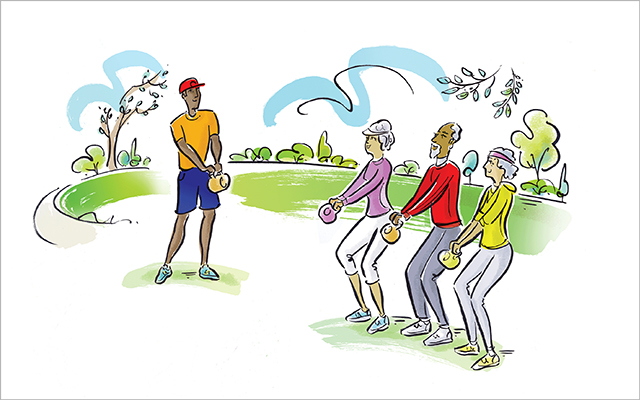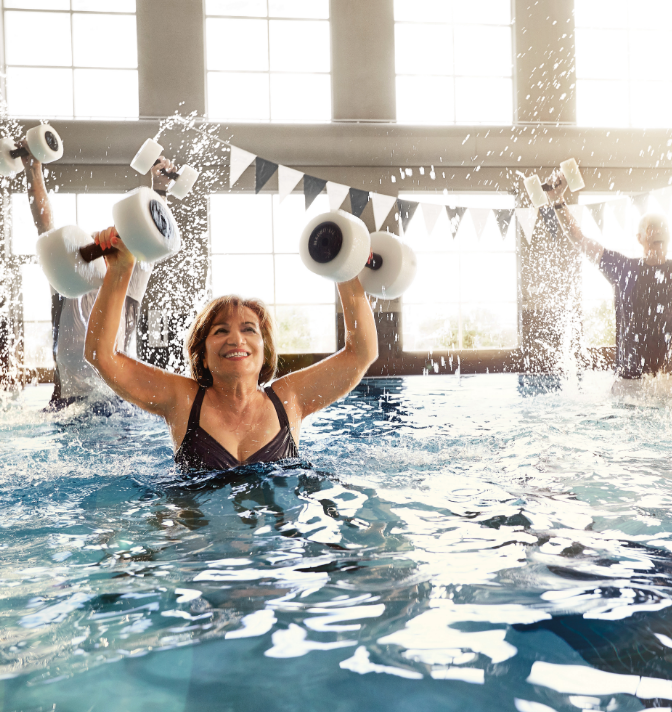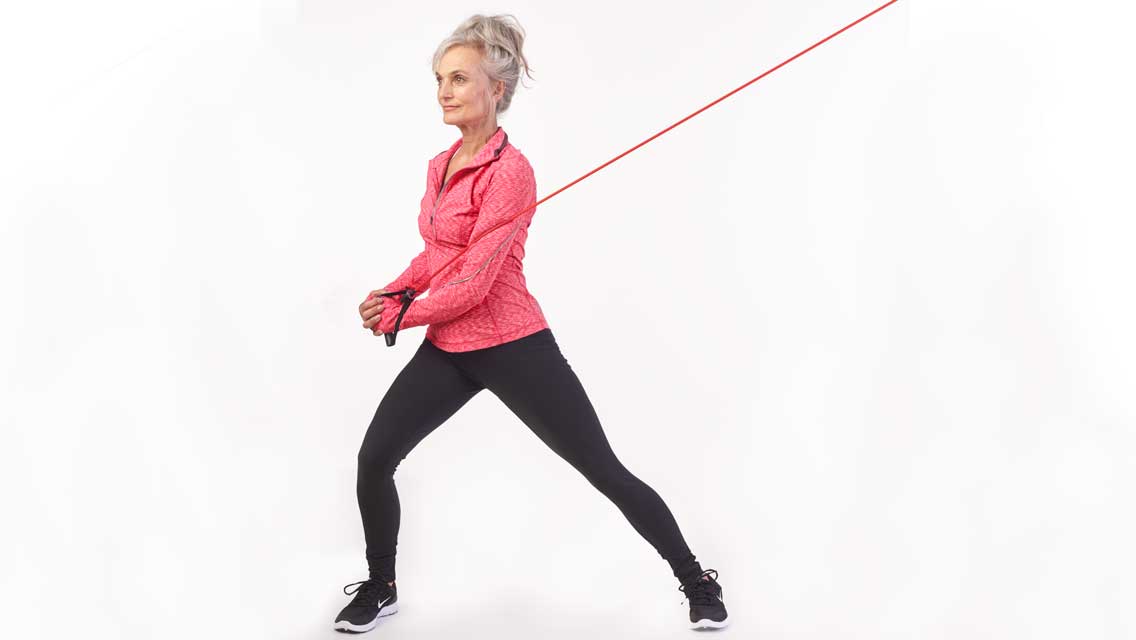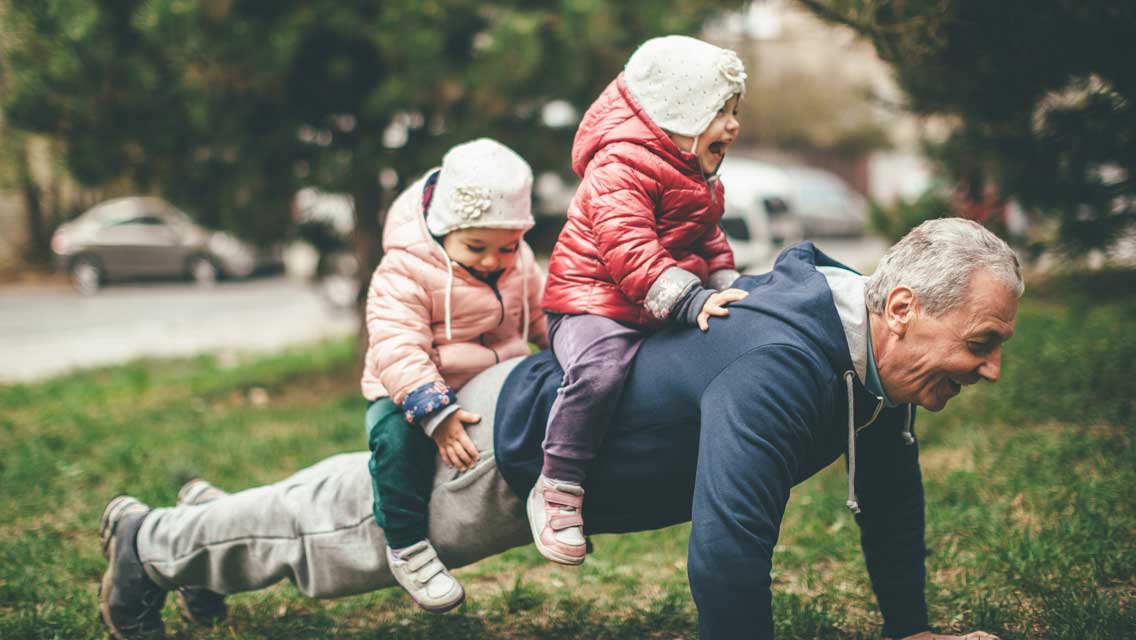ARTICLE SHORTCUTS
Teens and 20s | 30s | 40s | 50s | 60s | 70s | 80s, 90s and Beyond
Whether you’re 19 or 99, you can live your best, most active life. How that looks and feels will vary from decade to decade — even year to year — as your lifestyle and unique biology play out. But experts agree that, at any time, you have the ability to meet yourself where you are and maximize your fitness potential.
This isn’t to say that age has no bearing on fitness; all the changes your body undergoes during each phase of life require altering your approach to exercise. For the most part, this can be mapped out by the decades.
“Fitness is a marathon, not a sprint,” says Billy Anderson, NASM, a Life Time master trainer and instructor at Life Time Academy. It’s the accumulation of fitness over time that matters.
While the aging process unfolds differently for each of us, there are a few truths about exercising:
- Twenty-year-olds have more energy and fewer injuries than their 50-something counterparts.
- People in their 40s have different priorities and obstacles than those in their 70s.
- Focusing on strength, coordination, cardiovascular fitness, and mobility is vital at every age.
Perhaps most importantly, it’s never too late to start. Our decade-by-decade guide offers the latest insights on what it takes to stay fit for life.
In Your Teens and 20s: Commit
When you’re young, the workout world is your oyster. Want to take up sprinting, Olympic weightlifting, contact sports, rock climbing, martial arts? Go for it. All of it.
“As long as you understand the risks and benefits, you can choose whatever goals you want to pursue,” says Anoop Balachandran, PhD, NSCA-CSCS, an exercise physiologist and researcher at the Institute of Aging at the University of Florida, Gainesville.
You’re also extremely adaptable, so it’s a great time to explore, play, and learn new physical skills. “Younger people can handle new elements in their workouts every few weeks,” says Anderson, who trains teen athletes as well as octogenarians. Strong bones and muscles, fewer injuries, quick recovery, and naturally high levels of anabolic hormones allow you to make faster progress than at any other point in your life.
Exercising in early adulthood is your first step toward staving off osteoporosis, a major risk factor for fractures and frailty. “Your bone density at 30 determines your bone density later in life,” explains Balachandran, whose research focuses on improving physical function in older adults. Sprinting, dancing, and strength training in your teens and 20s stimulate bone growth so you have a larger store to draw from as you age.
Physical activity is beneficial for young people, who are naturally primed to soak up its rewards. The reality is that the majority of today’s youths, however, fall into one of two camps: Either they are athletes, engaging in one or many sports (as well as auxiliary training such as weightlifting and agility work, which can help create lifelong fitness habits) or they are sedentary.
These days, there’s little middle ground in our culture, as screen time takes up more of our work and social lives, suppressing movement. A 2017 study found that the average 19-year-old gets as much physical activity as the average 60-year-old.
Moreover, negative experiences in phys-ed classes and sports can leave a lasting impression.
That’s why it’s all the more important to instill a practice of enjoyable physical activity sooner rather than later. You’re only young once: Establish this essential, life-enhancing habit now.
In Your 30s: Streamline
Life tends to get more complicated in your 30s. Fun and frivolity give way to more obligations at home and work — and that often means less time and energy to exercise.
This is also the point at which exercise becomes more critical. Bone and muscle mass peak at the end of your 20s. Unchecked, sarcopenia, or muscle loss, can claim up to 50 percent of an inactive adult’s muscle tissue by the time he or she reaches 70, according to a 2014 Johns Hopkins University study. Your VO2 max — a measure of how much oxygen your body can process — declines similarly, dropping about 10 percent per decade after around age 30 in healthy sedentary adults of both sexes.
You’ll have a slightly tougher time getting fit now as you start to deal with the natural byproducts of aging. But an active lifestyle can mitigate, and even eliminate, many of these undesirable effects.
Work out now and you may become even fitter than you were in your 20s. Maintain an established exercise program and you’ll see little change — and possibly further improvements — in your fitness levels up to and past 35.
At this stage, efficiency and adaptability are key. “You can stay quite fit with just two workouts weekly,” says Anderson. “You just need to include as many components as possible in those workouts.”
Ten minutes of flexibility work, 30 minutes of strength work, and 10 minutes of cardio a couple of times weekly can keep you healthy and strong at this — or any — age. Even eight minutes of interval training on a bike, rower, or treadmill twice a week supports heart health, he explains.
One tool to combat the pull of the desk and couch at this phase of life is the electronic step counter. Anderson suggests shooting for 10,000 steps daily by taking the stairs, brief walks, and longer strolls whenever possible.
And when life prevents a trip to the gym, improvise: Work some pushups in after work, do some squats while playing with the kids, take a brisk walk before bedtime. (See “25 Ways to Make Time for Fitness” for more ideas.)
“At this age,” says trainer Fawn Friday, NSCA-CPT, “it’s all about squeezing fitness into the cracks in your schedule.”
In Your 40s: Hit Your Restart
Whether or not you’re a regular exerciser, life has a way of catching up with you by the time you hit 40.
For active types, nagging injuries nag a little louder; hard workouts deplete you a bit more. For serious recreational athletes, performance begins to drop, even if you maintain your training regimen. Whatever your sport of choice — be it distance running, competitive cycling, or pick-up basketball — you can expect your performance to plateau and recovery to take a bit longer.
People with sedentary jobs may also see some compounding changes around this time: “Eight hours a day in a chair can have serious effects after a decade or two,” says Friday. The hips, shoulders, rib cage, and ankles begin to tighten; back, neck, and knee pain also become common.
Many of these long-term minor pains and injuries can be traced to changes in the fascia — the pliable connective tissue running through your body. Over time, it dehydrates and stiffens in response to habitual movement patterns, whether active (such as jogging) or passive (such as sitting).
At this point, you’re likely to have established, and then broken, an exercise habit several times. That’s common, says Anderson. “I fully expect my clients to quit training at some point. The key is to go easy on yourself when you fall out of the exercise habit — and then steer yourself back to it.”
One remedy for the exercise doldrums is to keep exploring new types of movement, even if you’re already committed to a particular form of exercise. Novel activities — dance, martial arts, outdoor exercise — can work wonders for your brain, your mood, and your fascia. Massage, Rolfing, Feldenkrais, foam rolling, and other bodywork modalities can keep these tissues supple, too, so you can continue to move well, and without pain, for decades to come.
In Your 50s: Dial It Up
At 50, you may feel that your active days are behind you, but telling yourself you’re over the hill may hurt you more than the activities you’re avoiding.
“People tend to slow down at 50,” explains endurance coach Joe Friel, author of Fast After 50 and the Training Bible series. While active people in their 20s embrace higher-intensity exercise, he notes, those over 50 often choose less taxing activities.
These leisurely pursuits have their place, but there’s no substitute for the intensity of intervals and strength training or plyometrics. “When you reduce your intensity, athletic performance declines,” he says. “Cardiovascular fitness and other physiological metrics drop off.” Bone density suffers, too — particularly in women. In short, when you stop pushing yourself, you’ll become less fit, less healthy.
Conversely, says Friel, “When people include high-intensity interval training [HIIT], their cardio health remains high.”
With the right stimuli, bone density improves as well, says women’s health expert Belinda Beck, MD, an Arizona-based OB-GYN and researcher. In a recent study she conducted on postmenopausal women, Beck found that “even women with very low bone mass could tolerate the high loading required to increase bone mineral density as long as it was introduced gradually with close attention to technique.”
On the flip side, one major change many exercisers experience is a need for more recovery time between rigorous workouts. “Whereas a college athlete might be able to handle five sessions of hard sprints a week, someone in their 50s might be able to handle only one such workout a week,” says Friel.
So get those tough workouts in — but pay attention to biofeedback clues like soreness and fatigue in the following days. If you need an extra day before you feel ready to go hard again, take it.
In Your 60s: Challenge Yourself
You may be tempted to dial back on exercise now, but strenuous workouts will pay more dividends than ever.
“Almost every age-related illness — be it cardiovascular, metabolic, psychiatric, neurological, pulmonary, or cancer — has been shown to benefit from exercise in the form of improving quality of life, -lowering the risk of the disease, and decreasing mortality,” says Balachandran.
One near constant at this age is stiffer joints. Movement of all kinds — which floods joints with oxygenated blood — is helpful. But mobility and flexibility exercises that involve large, controlled ranges of motion in the ankles, hips, shoulders, and upper back can be particularly effective. Try a yoga class, and work mobility into your daily routine as well — anytime and anywhere. Gently stretch however it feels good, and as often as you remember.
“Balance exercises are as important as strength and endurance” when you’re over 60, adds Balachandran. Try single-leg balancing, walking a straight line, or traversing a low balance beam. Walk, jog, or run on uneven surfaces outside.
Finally, training for power as well as strength becomes increasingly important. It’s a safeguard against falling and other age-related declines in function that are common later in life.
“Power training could be more beneficial in improving physical function than regular strength training,” says Balachandran.
To try it, choose a medium-heavy weight (50 percent to 70 percent of your one-rep-max, or 1RM, if you know it). Lift it with as much velocity as you can muster, then lower it with control. For instance, if you are bench pressing, the push up will feel almost as though you are punching the weight up into the ceiling. Once you have completed the lift, slowly lower the weight to your chest. You can apply this technique using a variety of implements, including dumbbells, barbells, weight machines, elastic bands, and body weight, he explains.
Depending on how you feel, try other activities, such as tennis, rock climbing, or ballroom dancing. Whatever you choose, strike a balance between respecting your limitations and challenging yourself.
“Muscle responds the same way to exercise regardless of your age,” says Friday. “Your body remains adaptable all your life.”
In Your 70s: Make Haste Slowly
“Slow and steady wins the race,” says Anderson. There’s no reason you can’t continue to strength train, do cardio, stretch, hike, and even pursue higher-impact activities — as long as you take your time, monitor your response, and adjust accordingly.
“Chronological age is not a good indicator of biological age,” says Balachandran. “Some people who are in their 80s are as agile and vibrant as some in their 60s.” It’s not clear why, he notes. “But I think physical activity could be one overlooked factor.” The body deteriorates with time, yet how quickly and drastically those changes come may be largely up to you.
If you haven’t strength trained regularly, muscle loss may now reach critical levels, interfering with balance, gait, and other daily activities. But if you take up strength training, those changes are reversible: A number of studies including adults in their 70s have found that progressive strength training two or three times per week can lead to such improvements as increased muscle mass, more ease with everyday activities like climbing stairs and carrying groceries, and reduced joint pain.
You may need to do a longer warm-up and to rest more between sets by the time you reach 70, says Friday. “My older clients come in early to stretch, and they have to rest longer between sets. But they often finish their workouts stronger than my younger clients.”
Fit septuagenarians may even need to be held back: “Strength training is super empowering,” she says. “And people get excited when they see and feel the results. I have older clients doing multiple timed sets of kettlebell swings. One older client biked 2,700 miles in 50 days. It takes a little longer, but they can reach really impressive levels of fitness.”
Anderson concurs: “My over-70 clients do everything — high-intensity intervals, kickboxing, strength training.”
If this sounds overwhelming, Balachandran recommends recruiting a pro who can help you develop appropriate workout strategies: “Once you learn the basics, you can do it on your own,” he says. “The price you pay is negligible compared with the benefits.”
In Your 80s, 90s, and Beyond: Evolve
By this point, nearly everyone has aches and physical limitations from previous injuries or illnesses, arthritis, periods of sedentary living, or chronic overuse. You might be tempted to believe you’re too old to work out — and that rest is best.
But too much rest may do more harm than good. Once prescribed almost universally for back pain, illness, and discomfort of all kinds, bed rest has been shown in studies to be associated with loss of strength and endurance, changes in soft tissue, bone loss, joint disease, high blood pressure, and weakening of the cardiovascular system. It’s one reason falls are a danger for people over 80: The resulting injuries may heal, but the health complications from staying in bed for weeks can be irreversible.
Falls are a leading cause of death among people over 65 and contribute to more than 40 percent of all nursing-home admissions. So rest when you’re sick or injured — but get up and move as much as you’re able, as soon as you’re able.
The best way to avoid falling may be regular workouts. A 2016 study showed that exercise can reduce fall frequency by nearly 40 percent.
But fall prevention is just one benefit that physical activity confers upon adults over 80. In one study, a few weeks of weight training doubled the strength of 85-year-old men and women, with some seeing a reduced need for walkers and wheelchairs.
Exercise also reduces the likelihood of cognitive decline and Alzheimer’s. You may not respond the way you did when you were 19, but both your body and mind still derive considerable benefits from exercise — right up to and including your 10th decade.
The key to exercising safely and effectively now is the same as it was in your 20s: Find an enjoyable activity that challenges you without risking injury. Reducing impact or range of motion — by substituting cycling and swimming for jumping and running, or machine-based movements for free weights, for example — may be ideal.
Remember that your muscles, joints, bones, and entire body remain adaptable. And if you exercise consistently, what may have seemed impossible months or even years before can become possible — even easy and enjoyable.
Time marches on, and while we’re a long way from being able to stop the aging process, says Friel, “we can slow it down.”
Extra Reading
Find more information about healthy aging in the following articles and workouts.
All-Ages Strength Training: Boost your balance, power, and coordination — at any age — with this full-body strength-training workout.
Build Your Balance: The best way to improve your balance may be to keep at least one foot on solid ground.
The Fascia Connection: Just beneath your skin lies a complex network of connective tissue called fascia. It helps you move well, stand straight and play hard. Keeping it healthy might be one of the fastest — and most overlooked — ways to improve your health and fitness.
Feed Your Joints: Are your joints giving you trouble? Eating strategically can ease pain and minimize future damage.
Forever Fit: Getting older doesn’t have to mean retiring from your favorite activities and sports. Here’s your guide for staying fit for life.
How to Use Intuitive Training: Learn how to blend your exercise preferences with biofeedback to help you get stronger and fitter.
Jump Around: A Plyometric Workout: This full-body explosive workout focuses on speed and power to drive up your heart rate, boost your metabolism, and add a little pep to your step.
The Recovery Zone: Smart athletes know when to back off their hardcore training to rest and recover. Do you? The fitness gains you’re working so hard for can’t happen without some strategic breaks.
Steady-State Cardio Vs. High-Intensity Interval Training: Discover why a blend of both high- and low-intensity exercise is the best system of cardiovascular training.
Train Your Body, Train Your Brain: Get stronger and smarter with this functional routine that improves balance, coordination, power, and mental acuity.
Untangling Alzheimer’s: Breakthroughs in understanding dementia are leading to new healthcare approaches. Nutrition, lifestyle, and sleep may be the keys to prevention.
This originally appeared as “Your Fit Life” in the June 2018 print issue of Experience Life.





This Post Has One Comment
We all know that exercise is good for us. However, it accomplishes something beyond work on our actual wellness. It additionally lessens our danger of getting numerous infections, like malignant growth, coronary illness, or diabetes. It lessens pressure, assists us with dozing better, and it works on our psychological well-being. Since it accomplishes such a great deal for us, practice regardless age you are. A lifelong exercise program is the surest way of assisting you with living and flourish into advanced age.